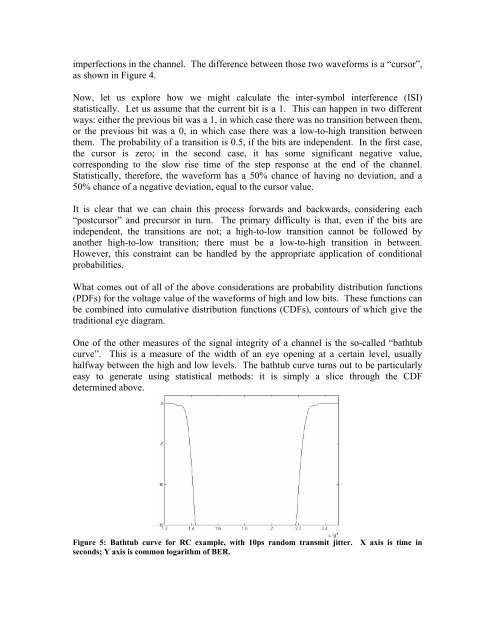DesignCon 2002
DesignCon 2002
DesignCon 2002
You also want an ePaper? Increase the reach of your titles
YUMPU automatically turns print PDFs into web optimized ePapers that Google loves.
imperfections in the channel. The difference between those two waveforms is a “cursor”,<br />
as shown in Figure 4.<br />
Now, let us explore how we might calculate the inter-symbol interference (ISI)<br />
statistically. Let us assume that the current bit is a 1. This can happen in two different<br />
ways: either the previous bit was a 1, in which case there was no transition between them,<br />
or the previous bit was a 0, in which case there was a low-to-high transition between<br />
them. The probability of a transition is 0.5, if the bits are independent. In the first case,<br />
the cursor is zero; in the second case, it has some significant negative value,<br />
corresponding to the slow rise time of the step response at the end of the channel.<br />
Statistically, therefore, the waveform has a 50% chance of having no deviation, and a<br />
50% chance of a negative deviation, equal to the cursor value.<br />
It is clear that we can chain this process forwards and backwards, considering each<br />
“postcursor” and precursor in turn. The primary difficulty is that, even if the bits are<br />
independent, the transitions are not; a high-to-low transition cannot be followed by<br />
another high-to-low transition; there must be a low-to-high transition in between.<br />
However, this constraint can be handled by the appropriate application of conditional<br />
probabilities.<br />
What comes out of all of the above considerations are probability distribution functions<br />
(PDFs) for the voltage value of the waveforms of high and low bits. These functions can<br />
be combined into cumulative distribution functions (CDFs), contours of which give the<br />
traditional eye diagram.<br />
One of the other measures of the signal integrity of a channel is the so-called “bathtub<br />
curve”. This is a measure of the width of an eye opening at a certain level, usually<br />
halfway between the high and low levels. The bathtub curve turns out to be particularly<br />
easy to generate using statistical methods: it is simply a slice through the CDF<br />
determined above.<br />
Figure 5: Bathtub curve for RC example, with 10ps random transmit jitter. X axis is time in<br />
seconds; Y axis is common logarithm of BER.
















